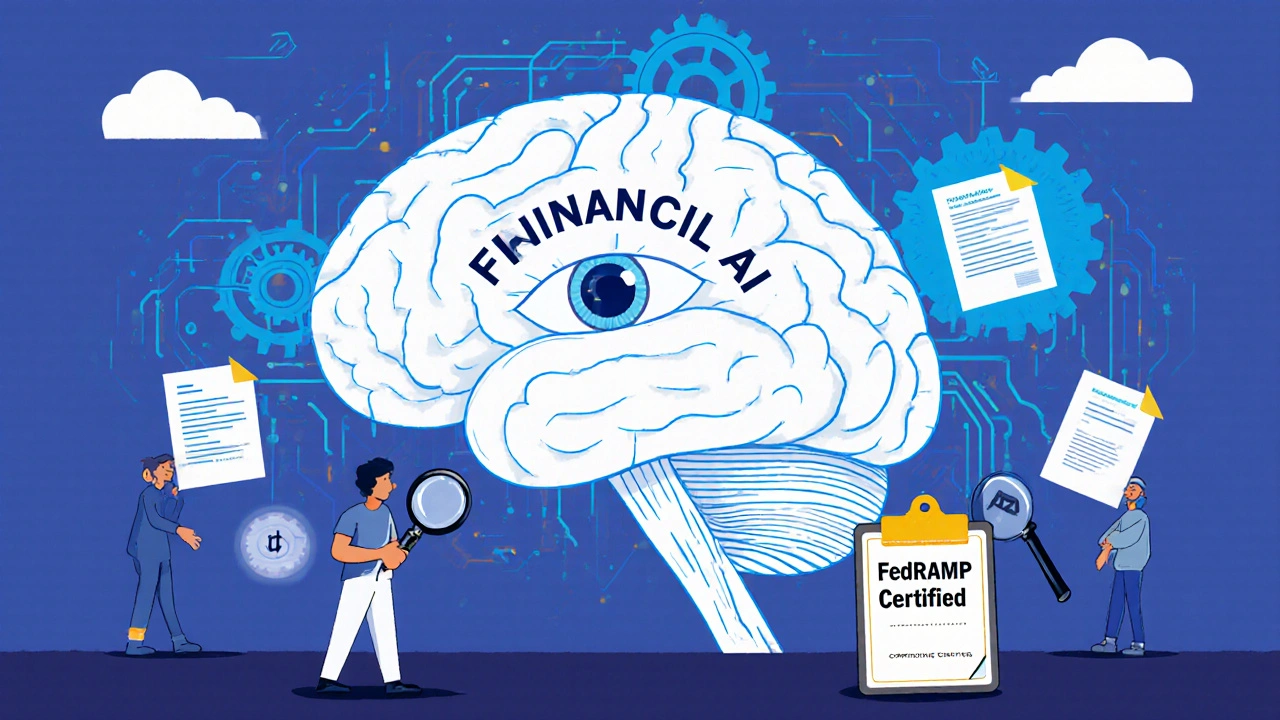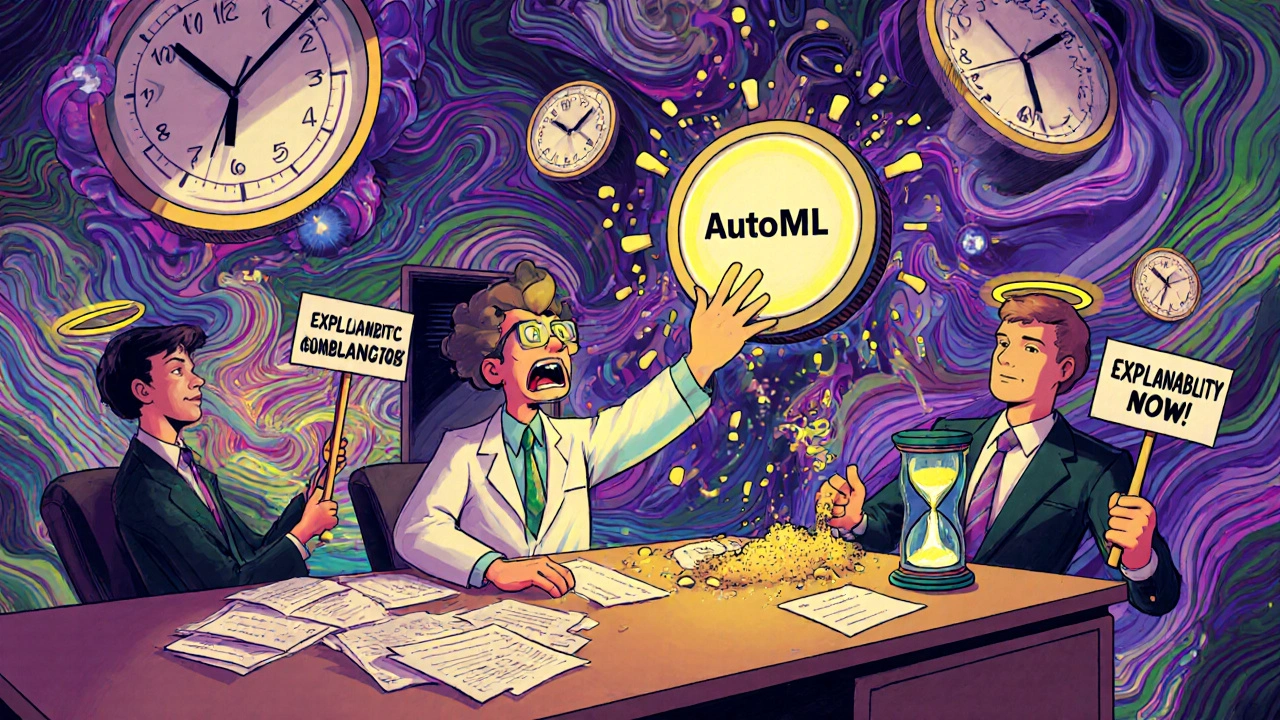Fintech AutoML Time Savings Calculator
Input Your Current Development Time
Estimated Time Savings
Enter your current development time to see how AutoML could accelerate your process.
Compliance Consideration
AutoML saves time (65-78% according to industry data), but not all use cases benefit equally. Complex regulatory models (like Basel III or derivatives pricing) may require manual oversight. Always involve compliance teams early.
AutoML is changing how fintech teams build models-fast
It used to take weeks to build a fraud detection model. Teams would spend days cleaning data, testing ten different algorithms, tweaking hyperparameters, and then fighting with compliance over why the model made a certain decision. Now, some fintech teams are doing the same work in hours. AutoML isn’t magic-it’s automation. But in finance, where speed and accuracy are locked together, that automation is making the difference between staying competitive and falling behind.
What AutoML actually does for fintech teams
AutoML stands for Automated Machine Learning. It doesn’t replace data scientists. It removes the repetitive, time-consuming tasks they used to do by hand: picking the right algorithm, scaling features, tuning parameters, and validating results. For fintech, that means you can test a new credit scoring model on Monday and have it running in production by Wednesday-not six weeks later.
But fintech AutoML isn’t just a generic tool like what you’d use for marketing or e-commerce. It’s built with finance in mind. Platforms like DataRobot Financial Services Edition and H2O Driverless AI for Finance come with pre-built templates for fraud detection, loan underwriting, and personalized financial advice. They know that financial data is messy, regulated, and sensitive. So they include built-in checks for things like bias, data leakage, and regulatory compliance-something generic AutoML tools ignore.
How much time are teams actually saving?
According to Intuz’s February 2025 analysis, fintech teams using AutoML cut model development time by 65% to 78%. PayPal reduced their fraud model iteration cycle from 10 days to just 72 hours after switching to an AutoML pipeline. That’s not a small win. In fraud, new patterns emerge every day. If your model takes two weeks to update, you’re already behind.
One European bank reported cutting their transaction monitoring model cycle from three weeks to four days. Accuracy stayed almost the same-94.7% vs. 95.2%. That’s the sweet spot: near-identical results, but 80% faster. And speed matters. The Financial Stability Board’s October 2025 report found that 28% of AI failures in financial institutions came from slow model updates. AutoML fixes that.
Where AutoML shines-and where it stumbles
AutoML is great for standard use cases:
- Fraud detection (PayPal hit 99.1% accuracy with AutoML)
- Customer personalization (budgeting tools, spending insights)
- Cross-border payment risk scoring
- Loan application screening (for standard profiles)
But it struggles with high-stakes, complex models:
- Derivatives pricing (too many variables, too little historical data)
- Capital adequacy calculations (Basel III rules are too rigid for automation)
- Niche credit risk models (Zestfinance found AutoML was 15-20% less accurate here)
Why? Because finance isn’t just about accuracy. It’s about explainability. Regulators don’t care if a model is 99% accurate if they can’t understand why it denied a loan. AutoML often creates black boxes. That’s why 68% of fintech teams say explainability is their biggest concern, according to Transcenda’s July 2025 survey.

The compliance trap
Here’s the hard truth: AutoML tools are fast, but many aren’t built for regulators. Sarah Chen from CBP Advisors warned in September 2025 that “many AutoML implementations fail to document the model selection process.” That’s a red flag during audits. Regulators want to know: Why did you pick X algorithm over Y? How did you validate the data? Who approved the final model?
That’s why platforms like H2O.ai launched their Model Audit Framework in March 2025. It automatically generates documentation for every step-algorithm choices, data splits, performance metrics. DataRobot’s April 2025 update added FedRAMP certification for government-related financial clients. These aren’t nice-to-haves anymore. They’re requirements.
Teams that ignore this end up spending more time fixing compliance issues than they saved building models. One Trustpilot review from a fintech firm said: “Great for standard use cases, but it took us three months to customize it for Basel III. We lost all the time savings.”
Who’s using it-and who’s not
Adoption is growing fast. AutoML now powers 37% of new ML projects in fintech, up from 22% in 2024, according to Dirox’s April 2025 report. But adoption isn’t even across the industry.
Fortune 500 banks: 82% use some form of AutoML. Why? They have the budget, compliance teams, and legacy systems to make it work. Startups? Only 37%. Most can’t afford the $150,000-$500,000 annual price tag of enterprise tools like DataRobot. They try open-source options like Auto-sklearn-but those require heavy customization. A junior developer might spend months just getting it to run.
Use case matters too:
- 68% of firms use AutoML for fraud detection
- 52% for customer personalization
- 39% for general risk assessment
- Only 18% for capital adequacy models
The pattern is clear: AutoML works best when the problem is well-defined, data-rich, and doesn’t require deep regulatory interpretation.
What you need to get started
AutoML isn’t plug-and-play. You need:
- Python 3.8+ or Java 11+
- Access to financial data sources (Snowflake, Databricks, internal warehouses)
- Cloud platform with financial compliance certs (AWS, Azure, or GCP)
- At least one data-savvy developer who understands SQL and financial data structures
The learning curve? Moderate if you’ve worked with ML before-2 to 4 weeks to get comfortable. If you’re a traditional finance developer with no coding background? Plan for 8 to 12 weeks. Most successful teams start small: pick one use case, like fraud detection, and run a pilot. Don’t try to automate everything at once.

Real feedback from the trenches
On Reddit’s r/FinancialTech, a March 2025 thread about AutoML in production got 147 comments. Seventy-eight percent said it was worth it. One senior developer wrote: “We used to miss new fraud patterns for weeks. Now we update models every 48 hours. Our fraud team says we’re finally keeping up.”
But the complaints are real. G2 Crowd’s September 2025 data shows AutoML platforms for fintech average 4.3/5 stars. High marks for ease of deployment (4.6) and speed-to-value (4.5). But lowest scores? Regulatory features (3.8) and customization (3.9). That’s the gap. Tools are fast-but still not smart enough for finance’s toughest rules.
The future: explainability and real-time learning
The next big leap isn’t speed-it’s transparency. Platforms are starting to combine AutoML with Generative AI to auto-generate model explanations. Imagine a fraud model that doesn’t just flag a transaction, but writes a plain-language report: “This payment was flagged because it matched 3 patterns seen in 92% of recent chargebacks, including unusual merchant category and timing outside business hours.”
By 2026, expect real-time model retraining-where models update themselves as new transactions flow in. And by late 2025, deeper integration with open banking APIs will let AutoML pull in real-time spending behavior to improve credit scoring.
The Financial Stability Board predicts that by 2027, 75% of new ML models in fintech will be built with AutoML. But only if they solve the explainability problem. Teams that don’t will see adoption drop by 30-40%. Those that do? They’ll own 60% of the market.
Bottom line: Use AutoML, but don’t trust it blindly
AutoML is the fastest way to build financial models today. It’s not perfect. It won’t replace human judgment on high-risk decisions. But for fraud, personalization, and standard risk scoring? It’s a game-changer.
Start small. Pick one use case. Make sure your compliance team is involved from day one. Demand documentation. Test rigorously. And never let speed override accountability. In finance, the most dangerous thing isn’t a slow model-it’s a model no one understands.






Comments
Let’s be real - AutoML in fintech is just fancy automation for people who don’t want to learn SQL or understand bias in credit scoring. I’ve seen teams deploy these tools like they’re magic wands, then panic when the regulator asks for a lineage trace. The ‘explainability’ part? A joke. Most platforms spit out some half-baked SHAP values and call it a day. Meanwhile, actual model governance teams are still manually auditing logs in Excel because the ‘audit framework’ only works if you pay extra for the enterprise tier. And don’t get me started on how ‘pre-built templates’ still require 37 custom patches to even touch Basel III. It’s not innovation - it’s vendor lock-in with a side of regulatory theater.
Actually, I tried AutoML for a small fraud detection pilot last year 😊. We used H2O with our internal transaction data - no fancy cloud setup, just a basic AWS instance. Took 2 weeks to get it running, but once it did, we caught 12 new fraud patterns in the first month that our old rule-based system missed. Not perfect? Nope. But it saved us 60 hours a month. Compliance docs? Yeah, we wrote them ourselves - took 3 days. Worth it. 🙏
Julia here - I appreciate how nuanced this post is. It’s rare to see a discussion that doesn’t just cheerlead automation or fear-monger about AI. The point about explainability being the real bottleneck? Spot on. I work with a regional bank that rolled out AutoML for loan screening, and while accuracy improved slightly, the compliance team nearly had a meltdown because the model couldn’t articulate why it rejected a 72-year-old applicant with a 20-year credit history. They had to manually override 17% of decisions. What’s fascinating is that the model’s logic was statistically sound - it just didn’t align with human intuition or regulatory expectations. That’s not a failure of tech. It’s a failure of design. The future isn’t just faster models - it’s models that speak the language of both data scientists and auditors. And yes, that’s going to require more than just a FedRAMP checkbox.